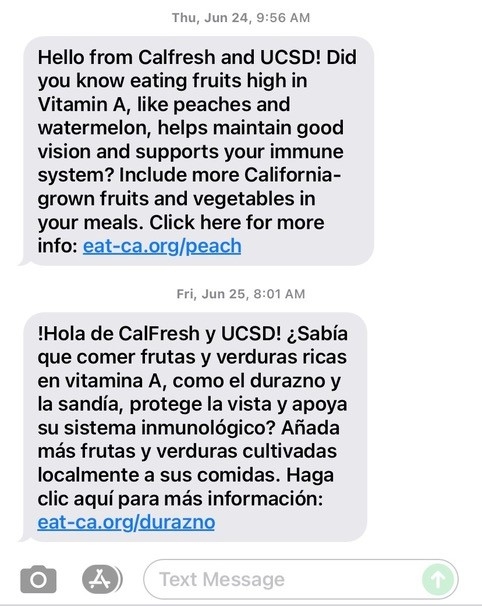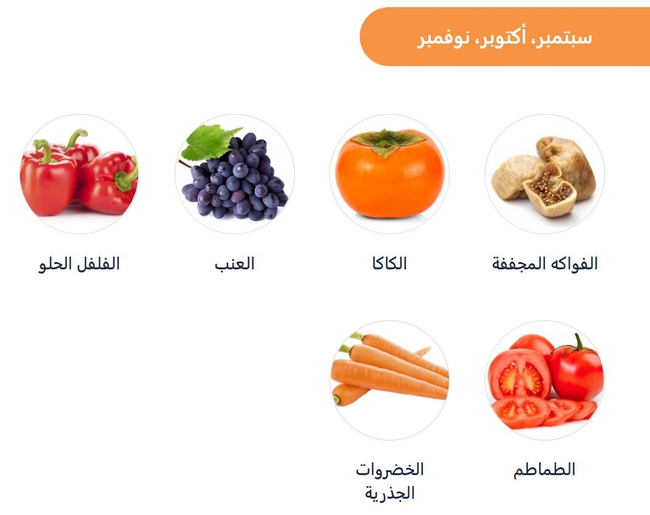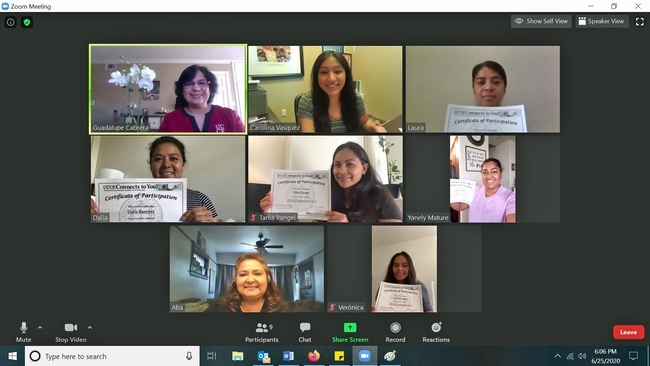- Author: Mike Hsu
The buzz or chirp of an incoming text message started some San Diego County residents on the path to a healthier diet during this past year. In September 2020, most CalFresh participants in the county – more than 172,000 households – began receiving monthly text messages about the benefits of California-grown fruits and vegetables as part of a pilot program.
This novel approach to delivering nutrition messages to California food assistance program participants was developed by a partnership of the Nutrition Policy Institute of UC Agriculture and Natural Resources, the UC San Diego Center for Community Health and the County of San Diego Health and Human Services Agency, which administers CalFresh in the county.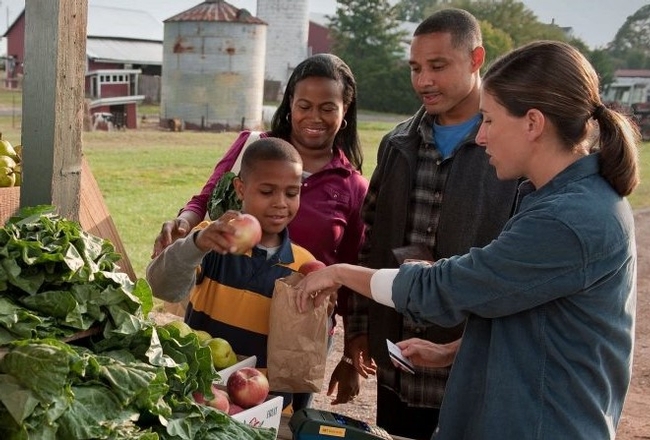
The HHSA, which had been using its text messaging platform to send administrative reminders and alerts, was receptive to using the tool for sending nutrition-focused information. NPI and CCH partnered with ideas42, a firm that applies behavioral science to solutions for social change, to develop a series of five text messages promoting California-grown fruits and vegetables.
The text messages – originally delivered in English and Spanish, with the addition of Arabic beginning in July 2021 – were friendly and conversational in tone.
“In a text, you have very few characters you're communicating with people, so we wanted to make sure we were using cutting-edge behavioral science to construct those messages to have the most impact,” said Wendi Gosliner, NPI senior researcher and policy advisor.
Each text included a link directing recipients to a website developed as part of the project, with information on selecting, storing and preparing California-grown fruits and vegetables; health benefits; tips to reduce food waste; and recipes – including TikTok videos.
Initially running from September 2020 to March 2021, the pilot program was well-received. Nearly 90% of CalFresh participants responding to a survey said they appreciated receiving the texts. “It is very important for us to eat healthy, to teach our children to eat healthy,” wrote one participant. “I love the recipes…they're so delicious and easy to make…I'm very, very grateful for the help because without you guys, I would be struggling more and I just want a better life for my children.”
Gosliner said it was encouraging to see that two-thirds of the approximately 5,000 survey respondents reported eating more California-grown fruits and vegetables after receiving the messages, and 85% expressed a desire to see more texts.
“What we see is that there's definitely a decent-sized population of people participating in CalFresh –now this is just in San Diego County but imagine the entire state – who would benefit from having this kind of information available to them,” Gosliner said. “And there is at least a subset of people who really liked it.”
UC San Diego's Center for Community Health was instrumental in facilitating the partnership between UC ANR and the HHSA. Further, CCH, in partnership with the San Diego County Childhood Obesity Initiative, formed a community council composed of residents representing diverse communities throughout San Diego County. Together, the council facilitated CalFresh participants to take part in focus groups, which provided feedback and guidance on the messaging and design for online resources. Gosliner said the success of the text program has been a direct result of community input and involvement.
“The Center for Community Health-led focus groups were integral to ensuring CalFresh resources were accessible and informative to a wide range of CalFresh participants, and local individuals and families more broadly,” said Blanca Meléndrez, executive director at the UC San Diego Center for Community and Population Health, Altman Clinical Translational Research Institute. “In the process, the text-based campaign also placed a greater focus on the local production of nutritious fruits and vegetables, ensuring access to healthy and nutritious food in all communities, and building new streams of income for the region's farmers and producers.”
This effort also suggests a simple way to reach CalFresh participants and bridge gaps between the Supplemental Nutrition Assistance Program and programming that offers nutrition education and healthy eating resources.
“By combining UCSD and UC ANR knowledge about healthy eating with our outreach capability, we are able to reach thousands of families via text message each month,” said Michael Schmidt, human services operations manager for the HHSA. “With the click of a button, these families are provided with resources to assist them in making healthier lifestyle choices, supporting a region that is building better health, living safely and thriving.”
The effort has been so effective that HHSA has asked for additional messages, beyond the original five months' worth of texts and resources.
“The partnership between UC ANR's Nutrition Policy Institute, UC San Diego's Center for Community Health, the County of San Diego Health and Human Services Agency and San Diego County community residents brought together a great team to develop an innovative, technology-based intervention,” said Shana Wright, San Diego County Childhood Obesity Initiative co-director at CCH. “Each partner provided knowledge, resources and assets that enhanced the project beyond the initial pilot phase, exceeding preliminary expectations.”
Gosliner said the pilot program has been a “great example and wonderful experience” of partnership in action.
“You can sit with your research or program ideas for a long time but if you don't have people who can help you implement them, then they really aren't helpful in any way,” she said. “In this case, it was just a nice combination of an idea…with partners who wanted to work to make something happen.”
- Author: Katie Panarella
- Author: Andra Nicoli
In the spring of 2020, UC Agriculture and Natural Resources' Expanded Food and Nutrition Education Program (EFNEP) and the CalFresh Healthy Living, UC (CFHL UC) Program faced the unprecedented experience of shelter-in-place and school closures due to COVID-19. Both federal nutrition education programs relied on in-person contact by UC Cooperative Extension nutrition education staff as a means of building and sustaining relationships with community members, stakeholders and partners serving vulnerable populations.
CFHL UC and EFNEP state office staff, in collaboration with the Center for Nutrition in Schools, reacted quickly to serve their clientele's needs. The coordinated effort of state office teams resulted in the dissemination of a staff needs assessment, which culminated in the training of over 150 educators and supervisors to quickly pivot lessons for online and distance learning. State staff and educators began designing online curricula delivery models to re-engage students, creating a library of virtual lessons with distance-learning strategies. This included using Zoom, social media platforms such as Facebook Live and YouTube, and learning platforms such as Google Classroom. To provide quality assurance, reach and outcome measures also began undergoing adaptation for this new learning environment.
Examples of new remote learning capabilities include:
-
More than 60 online lessons under development for children pre-kindergarten through 8th grade that emphasize healthy eating, active living and gardening.
-
CalFresh Healthy Living, UCCE county programs are developing the online delivery of five adult curricula, including UC-developed Plan, Shop, Save and Cook and Making Every Dollar Count that provide food resource management tips, as well as ideas for how to stay active and purchase healthy food on a limited budget. These lessons are particularly valuable at this time of high unemployment.
-
EFNEP's Technology and Social Media Plan includes a pilot of ‘blended learning' using mail, phone and video chat for our UCCE Connects to You Series. CFHL UC also utilizes mailings and phone call follow-ups with this curriculum.
Further, CFHL UC educators are offering lessons and short educational segments online, maintaining school gardens, working at food banks (with the permission of local county directors) and, in partnership with school meal programs, offering complimentary nutrition education and physical activity take-home lessons and resources to students and families at meal pick up locations. Youth engagement projects continue to engage student leaders online through Youth-Led Participatory Action Research (YPAR) projects.
In response to COVID-19, the EFNEP and CFHL UC state and county staff continue to build and enhance the skills of our educators while serving California's most vulnerable communities. These efforts are critical to maintain trusted relationships, which both programs successfully established over decades of service to promote healthy people and communities in California.
- Author: Pamela Kan-Rice
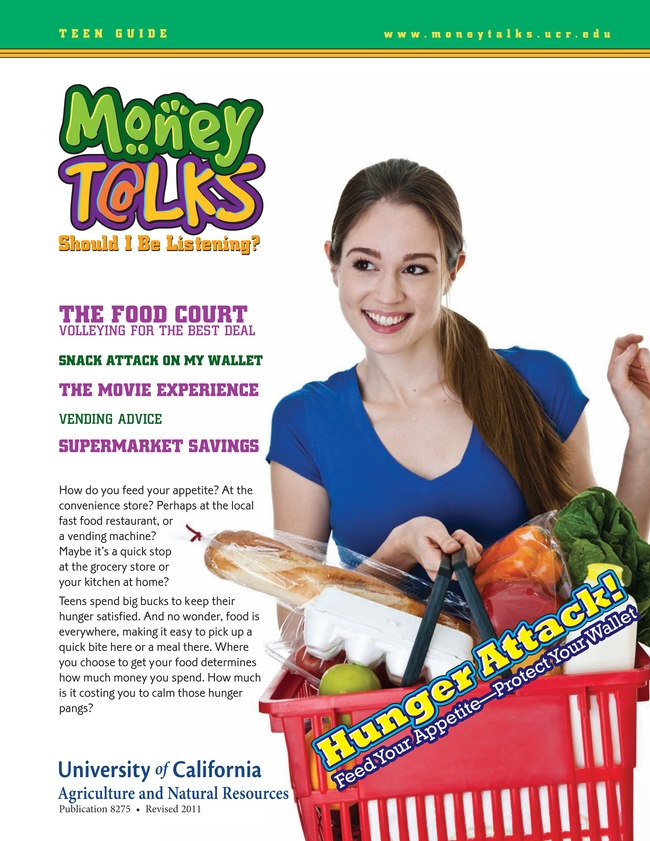
Because studies show that the habits we start early in life often carry into adulthood, UC Cooperative Extension reaches out to teenagers to develop money-management skills with a program called Money Talks. After completing the UC Money Talks program, teens are more likely to find easy ways to save money.
One feature of Money Talks helps teens improve their eating habits at the same time they work on their financial health. “Hunger Attack!” teaches youth how to buy food and save money.
This curriculum was developed to address connections between poverty and childhood obesity, explained Katherine Soule, UC Cooperative Extension advisor for youth, families and communities in San Luis Obispo and Santa Barbara counties.
“When young people are hungry, they are likely to buy food from the most convenient location,” said Soule. “That could be a fast food restaurant or a vending machine, rather than buying nutritious food at a lower price at a grocery store.”
The Hunger Attack program suggests writing a list of the food items purchased and the price so teens can see how the expenses add up. They may reconsider whether they really need to buy an after-school snack.
“We designed Hunger Attack to provide the teens with consumer facts, as well as develop their decision-making and reasoning skills to make the best nutrition decisions for themselves while making good financial choices,” Soule said. “In other words, we're teaching teens to look for the best nutritional value for their food dollars.”
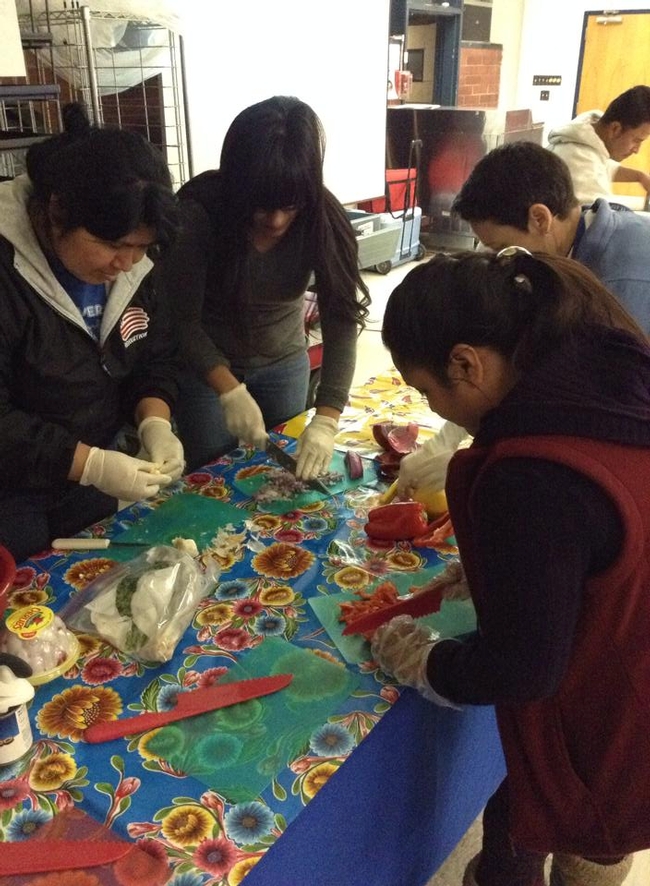
Money Talks provides money management techniques in magazine-style teen guides and an interactive website that features educational games and quizzes. The topics include money personality, easy ways to save money, shopping skills, car costs, developing skills for the workplace, buying snacks, savings accounts, checking accounts, e-banking, obtaining credit and credit cards.
Here's a sample quiz question:
The best time to go grocery shopping is when:
A. I'm really hungry.
B. I'm not hungry.
C. Everyone else is going
The answer is B. You're likely to buy more food when shopping on an empty stomach.
There is also a classroom curriculum for teachers, with leader's guides to accompany each of the teen guides. The leader's guides contain learning objectives; background information; discussion questions; activities with handouts, visuals, and links to the web site; a glossary of important terms; and additional resources. All of the materials are available in English and Spanish.
For more information, visit the Money Talks website at http://moneytalks4teens.ucanr.edu.


